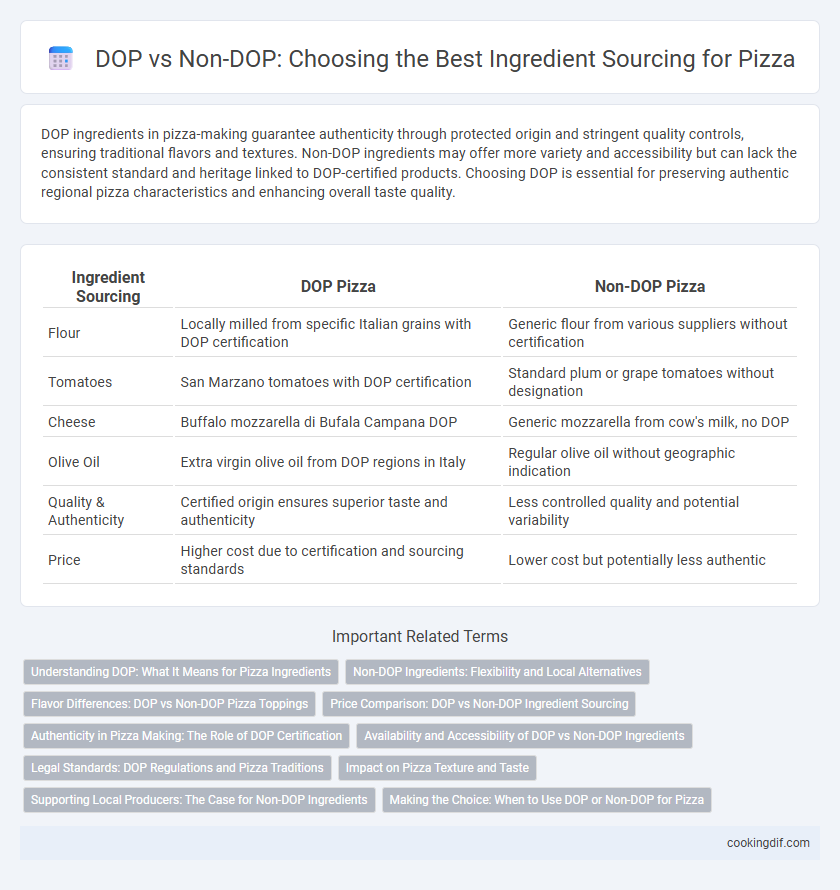DOP ingredients in pizza-making guarantee authenticity through protected origin and stringent quality controls, ensuring traditional flavors and textures. Non-DOP ingredients may offer more variety and accessibility but can lack the consistent standard and heritage linked to DOP-certified products. Choosing DOP is essential for preserving authentic regional pizza characteristics and enhancing overall taste quality.
Table of Comparison
| Ingredient Sourcing | DOP Pizza | Non-DOP Pizza |
|---|---|---|
| Flour | Locally milled from specific Italian grains with DOP certification | Generic flour from various suppliers without certification |
| Tomatoes | San Marzano tomatoes with DOP certification | Standard plum or grape tomatoes without designation |
| Cheese | Buffalo mozzarella di Bufala Campana DOP | Generic mozzarella from cow's milk, no DOP |
| Olive Oil | Extra virgin olive oil from DOP regions in Italy | Regular olive oil without geographic indication |
| Quality & Authenticity | Certified origin ensures superior taste and authenticity | Less controlled quality and potential variability |
| Price | Higher cost due to certification and sourcing standards | Lower cost but potentially less authentic |
Understanding DOP: What It Means for Pizza Ingredients
DOP (Denominazione di Origine Protetta) certification guarantees that pizza ingredients like mozzarella di bufala or San Marzano tomatoes come from specific regions in Italy, ensuring authenticity and superior quality. Non-DOP ingredients lack this regional guarantee, which can lead to variations in taste, texture, and overall pizza quality. Choosing DOP-certified components enhances the traditional flavor profile and maintains the cultural heritage essential to genuine Italian pizza.
Non-DOP Ingredients: Flexibility and Local Alternatives
Non-DOP ingredients offer greater flexibility in sourcing, allowing pizzerias to adapt recipes based on local availability and seasonal variations. Utilizing local alternatives can reduce costs and support regional producers while maintaining quality and freshness. This approach caters to diverse customer preferences and fosters innovation in pizza creation.
Flavor Differences: DOP vs Non-DOP Pizza Toppings
DOP pizza toppings, such as San Marzano tomatoes and Mozzarella di Bufala Campana, offer authentic, intense flavors due to strict geographic and production standards, enhancing the overall taste profile. Non-DOP ingredients often lack the unique terroir-driven qualities, resulting in milder, less complex flavors that can diminish the pizza's traditional character. This flavor distinction is critical for gourmet pizzas that rely on ingredient authenticity to deliver a true regional experience.
Price Comparison: DOP vs Non-DOP Ingredient Sourcing
DOP (Denominazione di Origine Protetta) ingredients for pizza, such as San Marzano tomatoes and Mozzarella di Bufala Campana, typically command higher prices due to strict quality standards and geographic authenticity. Non-DOP alternatives are significantly more affordable but may lack the distinctive taste and texture that justify the premium cost in authentic Italian pizza. Price comparison reveals that investing in DOP ingredients elevates production costs by up to 30-50%, impacting final menu pricing.
Authenticity in Pizza Making: The Role of DOP Certification
DOP certification guarantees that key pizza ingredients like San Marzano tomatoes and Mozzarella di Bufala Campana come from designated regions, preserving traditional flavors and production methods. Using DOP-certified products ensures authenticity, maintaining the original taste profile valued in classic Neapolitan pizza. Non-DOP ingredients may vary in quality and origin, potentially compromising the genuine sensory experience central to authentic pizza making.
Availability and Accessibility of DOP vs Non-DOP Ingredients
DOP (Denomination of Protected Origin) ingredients, such as San Marzano tomatoes and Mozzarella di Bufala Campana, come with strict geographic and production standards, ensuring authentic flavors but limited availability outside specific regions. Non-DOP ingredients offer greater accessibility and wider distribution, making them easier to source for pizzerias globally, though they may lack the unique qualities linked to their region of origin. The choice between DOP and non-DOP ingredients often balances authenticity and consistency with supply chain flexibility and cost-efficiency.
Legal Standards: DOP Regulations and Pizza Traditions
DOP (Denominazione di Origine Protetta) certification mandates strict legal standards to protect the authenticity of Italian pizza ingredients like San Marzano tomatoes and Mozzarella di Bufala Campana. These regulations ensure products are sourced from designated regions following traditional methods, preserving the unique flavor and quality essential to classic Neapolitan pizza. Non-DOP ingredients often lack these stringent controls, potentially compromising the authenticity and heritage associated with traditional pizza-making practices.
Impact on Pizza Texture and Taste
DOP-certified ingredients, such as San Marzano tomatoes and Mozzarella di Bufala Campana, ensure authentic flavor profiles and optimal moisture content that enhance pizza texture and taste. Non-DOP ingredients often lack consistent quality and specific regional characteristics, leading to variations in dough elasticity and topping juiciness. Using DOP products results in a balanced, crisp crust and rich, nuanced toppings that elevate the overall sensory experience of the pizza.
Supporting Local Producers: The Case for Non-DOP Ingredients
Non-DOP ingredients support local producers by encouraging the use of regionally sourced products that may not have official DOP certification but maintain authentic quality and flavor. Utilizing non-DOP ingredients promotes economic sustainability for small-scale farmers and artisans, fostering community resilience and preserving culinary traditions. This approach diversifies ingredient sourcing and helps maintain a rich, localized pizza flavor profile beyond standardized DOP options.
Making the Choice: When to Use DOP or Non-DOP for Pizza
Choosing DOP (Denominazione di Origine Protetta) ingredients ensures authentic regional flavors and strict quality controls, essential for traditional Neapolitan pizzas. Non-DOP ingredients offer flexibility and cost-effectiveness, suitable for creative or fusion pizza recipes that prioritize innovation over strict tradition. Use DOP products when authenticity and heritage matter most, and non-DOP when experimenting with diverse or budget-friendly options.
DOP vs non-DOP for ingredient sourcing Infographic

 cookingdif.com
cookingdif.com